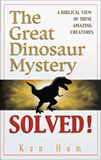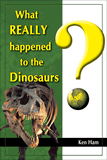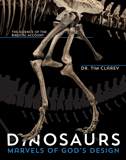
What Will You Do with Dinosaurs?
Of all the topics at the heart of the creation-evolution debate, perhaps none better encapsulates the issue than the question of dinosaurs. These fascinating animals—known mostly from fossil evidence—inspire awe and wonder in almost everyone; they sell millions of books and DVDs; and they captivate children like nothing else. But the question is this: what will you do with dinosaurs?
Hypotheses are easy to come by. Some well-meaning Christians once erroneously believed that dinosaur fossils were placed in the ground to test the faith of believers. Evolutionists, on the other hand, tell us that the fossil record proved that dinosaurs lived and died out millions of years ago—and later evolutionary beliefs state that this same fossil record proved that some dinosaurs did not truly die out, but rather evolved into birds. Beyond that, there are some cryptozoologists and even some purported eyewitnesses who claim that dinosaurs may have, in fact, somehow survived to the present day.
With so many ideas and beliefs, it’s tough to discern the truth from the noise. But what if the answer is not as mysterious as it seems? What if there is an eyewitness account of what happened to the dinosaurs?
According to the Bible, God created every kind of living creature over a period of six days around 6,000 years ago. Since this is true, being recorded in the inerrant Word of God, then humans and dinosaurs must have lived at the same time. Although this idea is often mocked by evolutionists who require long ages to make their beliefs seem valid, evidence that humans and dinosaurs coexisted is readily available when we look.
In fact, the Bible itself makes several mentions of “dragons,” which many scholars believe refer to dinosaurs (after all, the word dinosaur is a modern invention) and flying and marine reptiles. Genesis 1:21 refers to the great sea monsters that God created; Isaiah 27:1 also mentions the dragons in the waters; and, perhaps most famously, Job 40 describes a great creature which may have been a sauropod.
Beyond the Bible, ancient (and not-so-ancient) peoples depicted these creatures in their stories and in their art. For example:
- In the ancient Sumerian epic Gilgamesh, the hero encountered a huge dinosaur-like dragon, which he killed.
- Alexander the Great found that the peoples of India worshiped giant hissing reptiles, which they kept in caves.
- A tenth-century Irishman described seeing what appears to be a Stegosaurus, though this was hundreds of years before the fossils of this animal would be unearthed.
- There are dinosaur petroglyphs and artifacts the world over, such as at Angkor Wat.
- [See more in “What Really Happened to the Dinosaurs?”]
Dr. Jason Lisle shows how to understand dinosaurs through “biblical glasses.”
The Bible makes sense of dinosaurs and the evidence that humans encountered them. It also tells us why we no longer see them today: the worldwide Flood of Noah’s day destroyed most of these creatures (as well as everything and everyone that breathed air and dwelt on land that were not inside the Ark), and the rest slowly died out because of the changing environment and the spread of humanity from Babel.
Dinosaurs are awe-inspiring creatures, but they are not a mystery. The Bible, which is God’s Word to us, gives us the true history of the world. But there’s more than just dinosaurs in those pages; there’s the greatest story of all.
Don’t Just Wonder—Get Answers
Recommended Resources

Answers in Genesis is an apologetics ministry, dedicated to helping Christians defend their faith and proclaim the good news of Jesus Christ.
- Customer Service 800.778.3390
- © 2024 Answers in Genesis




